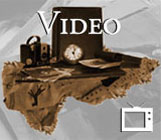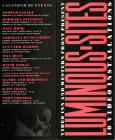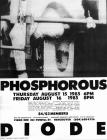1
Video's suitability for social documentary was immediately apparent, but recognition of it as an art form was slow in coming. While Canadian artists were some of the first to pioneer the medium, and artist-run media centres were in almost every province by the 1980s, the public, and many civic and traditional art institutions, were reticent to accept that video could also be art.For the public, the idea that anything displayed on a video monitor could be anything other than television was profoundly puzzling. If it didnít look like commercial television, it was simply bad television. For galleries, the questions of how to contexualize video art for a largely uninformed audience, how to incorporate the relative frenzy of electronic images and soundtracks into the traditionally hushed gallery space, the lack of technical - and sometimes curatorial - expertise, marginalized and delayed the entry of video into many galleries.
Then there was the persistent debate about whether video with social or political content could ever be considered art. Vancouverís most infamous incident concerning these questions occurred in 1984. Video Inn founder Paul Wong produced a verbally-explicit video piece about sexuality entitled "Confused Sexual Views." He was contracted to exhibit it at The Vancouver Art Gallery. The Gallery, which had enthusiastically facilitated experimentation with the medium in the late 60s, would cancel the exhibition one day before its scheduled opening. VAG Director, Luke Rombout had decided the work did not have artistic merit. A part of his defense of that decision lay in Wongís use of the ubiquitous "talking head" format of broadcast. Whether it was the form or the content that sparked his response, it was obvious that his reductive take resonated with much of the public.
The resulting court battle and high-profile public debates over "Confused" raised awareness of the issue of institutional censorship and video art itself. It also helped inform a generation of art activists, curators, and civil libertarians. This incident, among other art censorship cases across North America, can be credited for the re-examination by some cultural institutions of their curatorial practices, relationship to the artist community, and video community specifically.
Despite early frustrations, video art asserted itself through most cultural institutions as the 1980s progressed. In 1986, Video Inn and Western Front co-sponsored "Luminous Sites," an ambitious video installation series that took place in a variety of venues, including the Vancouver Art Gallery, throughout the city. This high profile event piqued the curiousity of Vancouverites and furthered the discussion about the video art in the public realm.
Sources:
Crista Dahl Media Library & Archive
"Making Video 'In'", Editor Jennifer Abbott, Video In Studios, 2000.
2
Carla Wolf: But is it art?2013
VIVO Media Arts Centre, 1965 Main Street, Vancouver, British Columbia, Canada
 Credits:
Credits:Interviewer: Kevin Doherty
Cameraperson: Anna MacDonald
Editor: Kevin Doherty
Transcript: Kevin Doherty
3
Video Installation: "Confused: Sexual Views"1984
Vancouver, British Columbia, Canada
 Credits:
Credits:Director: Paul Wong
Producers: Gary Bourgeois, Gina Daniels, Jeanette Reinhardt, Paul Wong
4
Paul Wong: Anti-Art, Anti-Commodity2013
VIVO Media Arts Centre, 1965 Main Street, Vancouver, British Columbia, Canada
 Credits:
Credits:Interviewer: Kevin Doherty
Cameraperson: Anna MacDonald
Editor: Kevin Doherty
Transcript: Kevin Doherty
5
Video Installation: "Luminous Sites" BrochureFebruary 23 - April 4, 1986
Vancouver, British Columbia, Canada
 Credits:
Credits:Co-produced by Video Inn and Western Front
Curated by Daina Augaitis and Karen Henry
6
Video and Performance Art: "Breath"1985
Vancouver, British Columbia, Canada
 Credits:
Credits:Artist: Margaret Dragu
7
Peg Campbell: Artists as innovators2013
VIVO Media Arts Centre, 1965 Main Street, Vancouver, British Columbia, Canada
 Credits:
Credits:Interviewer: Kevin Doherty
Cameraperson: Anna MacDonald
Editor: Kevin Doherty
Transcript: Kevin Doherty
8
"Baby Eyes" excerpt and the Aniputer1983
Vancouver, British Columbia, Canada
 Credits:
Credits:Artist: Elizabeth Vander Zaag
9
Phosphorous Diode Exhibition: FlyerAugust 1985
Video Inn, 261 Powell Street, Vancouver, British Columbia, Canada
 Credits:
Credits:Curator: Karen Henry
10
Crista Dahl: Mainstream Acceptance of Video Art2013
VIVO Media Arts Centre, 1965 Main Street, Vancouver, British Columbia, Canada
 Credits:
Credits:Interviewer: Kevin Doherty
Cameraperson: Anna MacDonald
Editor: Kevin Doherty
Transcript: Kevin Doherty